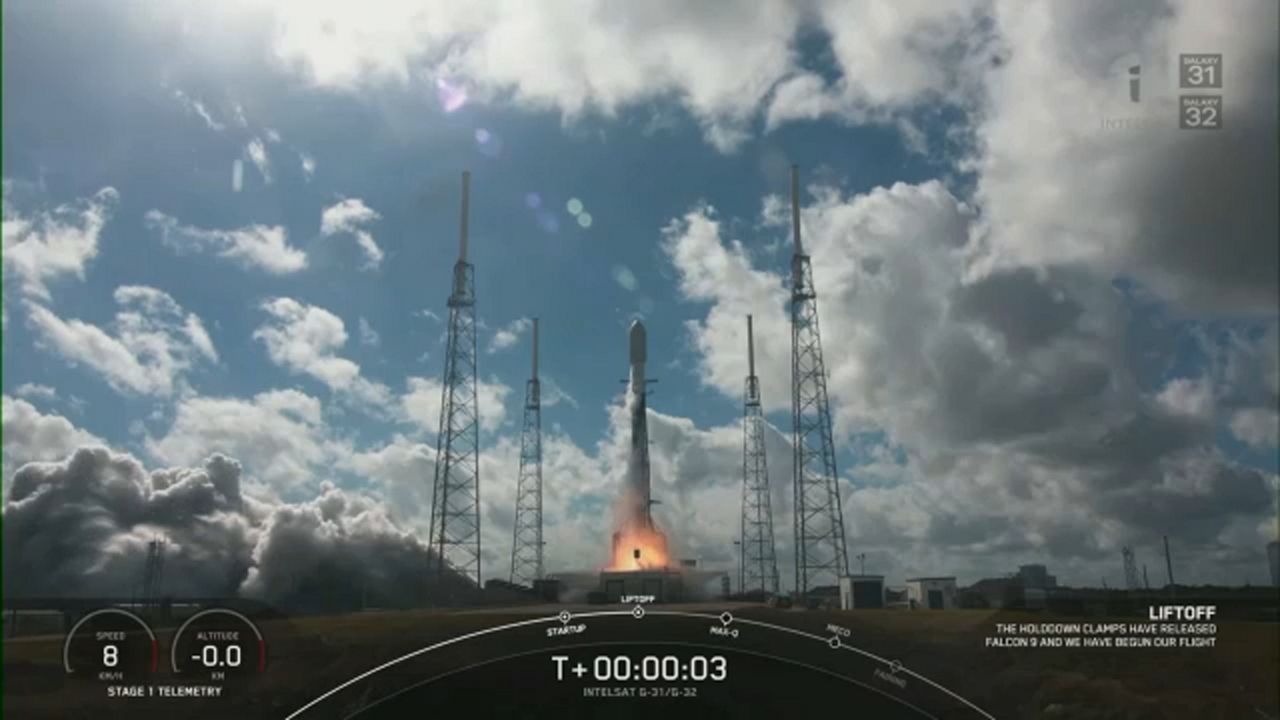SpaceX launched a pair of satellites for Intelsat on Saturday, after the wide-reaching impacts of Hurricane Nicole delayed but didn’t dampen the launch plans for the communications company.
The Galaxy 31 (G-31) and Galaxy 32 (G-32) satellites are part of the company’s newest slate of satellites in its North America Galaxy Fleet servicing primarily broadcast companies. The Maxar-manufactured satellites launched aboard a SpaceX Falcon 9 rocket on Saturday, Nov. 12 during a two-hour launch window opening at 11:06 a.m. EDT.
What You Need To Know
- SpaceX successfully launched a pair of satellites for Intelsat on Saturday
- It will be the second replacement pair for Intelsat’s Galaxy constellation
- The satellites support broadcast customers in North America
- SpaceX set to launch five of the seven total replacement satellites for Intelsat
Liftoff! pic.twitter.com/u2frCG8Jji
— SpaceX (@SpaceX) November 12, 2022
“This program started back in March 2020. Intelsat procured seven C-band satellites as a replacement for the Galaxy Fleet,” said Jean-Luc Froeliger, the senior vice president of space systems for Intelsat. “Galaxy Fleet has 11 satellites and seven of those 11 satellites are being replaced as we speak.”
Media companies in the U.S. will be the beneficiaries of these newer satellites, Froeliger said. He added that it would allow broadcast customers “to use smaller receiver antennas and have better performance, especially in the case of bad weather.”
Galaxy 31 and 32 have arrived in Florida! 🛰️
— Intelsat (@INTELSAT) October 28, 2022
This launch continues Intelsat’s Galaxy fleet refresh plan. G-31 and G-32 are third and fourth in a total of seven new Galaxy satellites launching in the next six months. This launch follows G-33 and G-34 launched last month. pic.twitter.com/rwXLeZGCNf
Two of those replacements, Galaxy 33 and Galaxy 34, launched on a Falcon 9 from Cape Canaveral Space Force Station back on Oct. 8.
Froeliger said in a media roundtable on Monday that G-33 began operational service last weekend and G-34 was finishing its in-orbit testing and would join in service soon.
The G-35 and G-36 satellites will also launch as a pair, but will fly aboard an Arianespace Ariane 5 rocket sometime in the remainder of 2022.
The last of the satellites, G-37, was originally set to launch aboard an Ariane 6 rocket, but because of development delays, it will launch on a Falcon 9 from Florida instead.
“It’s both a C-band and Ku-band satellite and this one is launching next year. Right now, we’re looking at a June launch,” Froelieger said. “It will be a Falcon 9 dedicated launch.”
Deployment of @Intelsat Galaxy 34 confirmed pic.twitter.com/mKXMS7kbsy
— SpaceX (@SpaceX) October 8, 2022
Froeliger noted that this mission would be unique from most other Falcon 9 flights. The G-33/G-34 mission, for instance, used a Falcon 9 5500, which is designed for reuse by SpaceX. However, because of the orbital needs for the G-31/G-32 mission, it will use an expendable version of the Falcon 9.
That will cost Intelsat more to use a non-reusable version of a Falcon 9, but the company did not disclose the exact cost.
“The expendable launch vehicle was needed for this mission, due to the characteristics of the Maxar satellites,” Froeliger said. “This is the first time Maxar launches a stack of 1300s together and in order for us to achieve a good, orbital lifetime, meaning greater than 15 years, we had to go to a Falcon 9 expendable and there’s a premium to be paid.”
G-32 will deploy about 33 minutes after liftoff and G-31 will separate about five minutes late. G-31 is set to begin service in January 2023 with G-32 following a month later.
Intelsat has been launching satellites from Florida going back to 1965 with the launch of the Intelsat 1 mission, marking the world’s first commercial communications satellite to go into orbit.
The company helped carry the first live global television broadcast with the “Our World” TV special in 1967. Its satellites also supported the international broadcast of the Apollo 11 landing in 1969.
Intelsat was created in 1964 as the International Telecommunications Satellite Organization to “own and manage a constellation of communications satellites providing international broadcast services,” according to the company.
Watch here:



